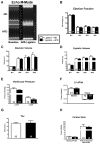High fat feeding in mice is insufficient to induce cardiac dysfunction and does not exacerbate heart failure
- PMID: 24367585
- PMCID: PMC3867436
- DOI: 10.1371/journal.pone.0083174
High fat feeding in mice is insufficient to induce cardiac dysfunction and does not exacerbate heart failure
Erratum in
- PLoS One. 2014;9(11):e113944
Abstract
Preclinical studies of animals with risk factors, and how those risk factors contribute to the development of cardiovascular disease and cardiac dysfunction, are clearly needed. One such approach is to feed mice a diet rich in fat (i.e. 60%). Here, we determined whether a high fat diet was sufficient to induce cardiac dysfunction in mice. We subjected mice to two different high fat diets (lard or milk as fat source) and followed them for over six months and found no significant decrement in cardiac function (via echocardiography), despite robust adiposity and impaired glucose disposal. We next determined whether antecedent and concomitant exposure to high fat diet (lard) altered the murine heart's response to infarct-induced heart failure; high fat feeding during, or before and during, heart failure did not significantly exacerbate cardiac dysfunction. Given the lack of a robust effect on cardiac dysfunction with high fat feeding, we then examined a commonly used mouse model of overt diabetes, hyperglycemia, and obesity (db/db mice). db/db mice (or STZ treated wild-type mice) subjected to pressure overload exhibited no significant exacerbation of cardiac dysfunction; however, ischemia-reperfusion injury significantly depressed cardiac function in db/db mice compared to their non-diabetic littermates. Thus, we were able to document a negative influence of a risk factor in a relevant cardiovascular disease model; however, this did not involve exposure to a high fat diet. High fat diet, obesity, or hyperglycemia does not necessarily induce cardiac dysfunction in mice. Although many investigators use such diabetes/obesity models to understand cardiac defects related to risk factors, this study, along with those from several other groups, serves as a cautionary note regarding the use of murine models of diabetes and obesity in the context of heart failure.
Conflict of interest statement
Figures







References
-
- Ogden CL, Flegal KM Prevalence of Obesity in the United States, 2009–2010. U.S. DEPARTMENT OF HEALTH AND HUMAN SERVICES. Centers for Disease Control and Prevention. National Center for Health Statistics In: Statistics USDOHAHSCfDCaPNCfH, editor
Publication types
MeSH terms
Substances
Grants and funding
LinkOut - more resources
Full Text Sources
Other Literature Sources
Medical
Miscellaneous

